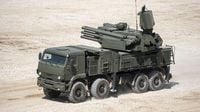Amid a rapidly shifting global security landscape, the past month has seen a dramatic escalation in both Eastern European and Latin American military tensions, with Russia ramping up its aerial bombardment campaign in Ukraine and expanding military support to Venezuela. These developments, reported by Ukraine's Defense Ministry and corroborated by Russian officials, have prompted sharp responses from the United States and its allies, raising concerns over the potential for broader conflict and drawing comparisons to some of the most fraught moments of the Cold War.
According to a November 4, 2025, report from Ukraine's Defense Ministry, Russia dropped a record 5,328 guided aerial bombs on Ukrainian territory in October alone. This figure marks the highest monthly total since the beginning of 2025 and underscores a significant intensification of what Kyiv has labeled "air terror." The ministry noted that since January, over 40,000 aerial bombs have been launched against Ukraine—roughly matching the total for all of 2024. This sharp uptick in attacks has left cities and military positions near the front lines, particularly in the oblasts of Donetsk, Dnipropetrovsk, and Zaporizhzhia, under near-constant threat.
Guided aerial bombs, as described by defense experts cited in The Express, are less expensive to produce than missiles and can be launched from aircraft operating deep within Russian or Russian-occupied territory. Their heavy iron construction and high-altitude, high-speed approach make them nearly impossible for Ukrainian air defenses to intercept. Notably, Russia has recently upgraded these bombs, extending their range to up to 200 kilometers (nearly 125 miles), which allows strikes to reach well beyond the immediate front lines and threaten urban centers previously considered relatively safe.
Recent incidents illustrate the breadth of the threat. On October 30, 2025, the Ukrainian air force reported a guided bomb heading toward Dnipro, one of the country's major cities. Just days later, on November 4, Suspilne Zaporizhzhia confirmed a Russian guided bomb strike on a settlement in the Zaporizhzhia oblast. The cumulative effect of these attacks has been devastating for civilian infrastructure and morale, with the Defense Ministry warning that "air terror is intensifying."
While Ukraine grapples with this barrage, Russia's military ambitions are also playing out on another continent. In a statement to Russian media outlet Gazeta.Ru, Alexei Zhuravlev, First Deputy Chairman of the State Duma Defense Committee, revealed that Russia had recently delivered Pantsir-S1 and Buk-M2E air defense systems to Venezuela. The delivery, reportedly transported by an Il-76 aircraft that arrived in Caracas on October 26, 2025, marks a significant deepening of military-technical cooperation between Moscow and the government of Venezuelan President Nicolas Maduro.
"Russia is actually one of Venezuela’s key military-technical partners; we supply the country with virtually the entire range of weapons, from small arms to aircraft," Zhuravlev told Gazeta.Ru. He highlighted that Russian Su-30MK2 fighters form the backbone of the Venezuelan Air Force and that earlier deliveries of S-300VM (Antey-2500) battalions have "significantly strengthened the country’s ability to protect important installations from air attacks."
Perhaps most alarming for U.S. policymakers, Zhuravlev suggested that Moscow could supply Venezuela in the future with long-range strike weapons, including the Oreshnik intermediate-range ballistic missile and the Kalibr cruise missile. The Oreshnik, which has been used by Russia against Ukraine, boasts a maximum range of about 3,400 miles—enough to threaten much of the continental United States and Puerto Rico, which is currently being used as a staging base for U.S. operations in the Caribbean. The Kalibr cruise missile, with a range between 930 and 1,550 miles, could potentially threaten the southern U.S. and various Caribbean facilities.
"I also see no obstacles to supplying a friendly country with new developments like the Oreshnik or, say, the proven Kalibr missiles; at least, no international obligations restrict Russia from doing so," Zhuravlev asserted. While the actual transfer of such weapons remains speculative, the mere possibility has already heightened tensions and drawn historical parallels to the Cuban Missile Crisis of 1962.
Responding to these developments, the U.S. has bolstered its military presence in the region. The U.S. Navy aircraft carrier USS Gerald R. Ford, along with its escort USS Bainbridge, passed through the Strait of Gibraltar and entered the North Atlantic as of November 4, 2025, en route to the Caribbean. According to The War Zone, the carrier is part of a larger deployment that includes eight surface warships, a nuclear-powered fast attack submarine, the MV Ocean Trader (a roll-on/roll-off cargo ship modified for special operations), and a formidable array of aviation assets such as F-35B stealth fighters, AC-130 gunships, airlifters, and MQ-9 Reaper drones. These forces are supporting an enhanced counter-narcotics operation in the region, but their presence is also widely seen as a signal to both Caracas and Moscow.
The Trump administration, meanwhile, is weighing a range of military options for Venezuela. As reported by The New York Times, these options include direct attacks on military units protecting Maduro and even seizing control of the country's oil fields. However, President Trump has yet to make a final decision, with officials noting his reluctance to approve operations that might endanger American troops or risk a high-profile failure. Nonetheless, senior advisers are reportedly pressing for aggressive action, and the administration has sought additional legal guidance that could justify strikes against Maduro without requiring Congressional authorization.
In the midst of these maneuvers, the U.S. has also intensified operations against alleged drug trafficking organizations, both in the Caribbean and the Pacific. President Trump celebrated recent successes on his Truth Social platform, posting, "U.S. military captures another drug speedboat and seizes over 5,000 lbs of drugs and apprehends nearly 60 narco terrorists as part of its Operation Pacific Viper."
However, the aggressive U.S. posture has drawn criticism and concern from regional leaders. On November 4, 2025, Mexican President Claudia Sheinbaum publicly rejected the idea of American kinetic actions against Mexican cartels, stating, "It’s not going to happen. We do not agree with any process of interference or interventionism." Her remarks underscore the delicate balance Washington must strike as it pursues its objectives in the hemisphere.
For now, the world watches as the U.S., Russia, and their respective allies engage in a high-stakes game of brinkmanship, with Ukraine and Venezuela as flashpoints. Whether this escalation will lead to direct confrontation or remain a tense standoff remains to be seen, but the consequences for global security are undeniably profound.




